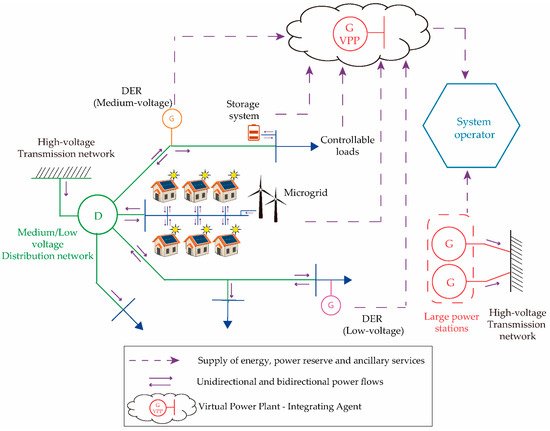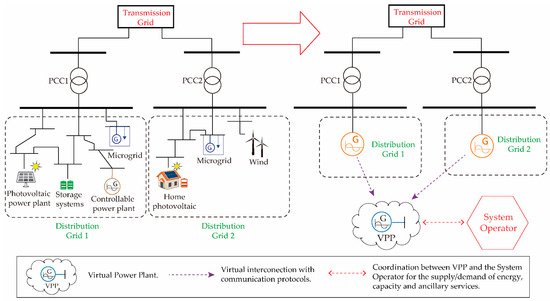A virtual power plants (VPPs) is an alternative for the management of Distributed Energy Resources (DER) in the electricity system, which operates based on the concept of the “virtual cloud”. Its specific role is visibility and the technical and commercial integration of DERs in the power system.
It is capable of grouping and managing the technical potential of different DERs (microgrids included), regardless of the voltage level at which they are interconnected with the network and without a geographical restriction between the elements.
It is modeled as a single virtual element associated with the distribution network to guarantee a safe, efficient, cooperative and complementary operation between its elements, both in commercial and technical aspects.
The VPP has the capacity to participate in the electricity market as a manager of controllable loads and as a provider of energy, power reserve and ancillary services.
- smart grid
- virtual power plant
- distributed generation
1. Definition and Scope of Virtual Power Plants (VPPs)

-
A VPP is an alternative for the management of DERs in the electricity system, which operates based on the concept of the “virtual cloud”. Its specific role is visibility and the technical and commercial integration of DERs in EPS.
-
It is capable of grouping and managing the technical potential of different DERs (microgrids included), regardless of the voltage level at which they are interconnected with the network and without a geographical restriction between the elements.
-
It is modeled as a single virtual element associated with the distribution network to guarantee a safe, efficient, cooperative and complementary operation between its elements, both in commercial and technical aspects.
-
The VPP has the capacity to participate in the electricity market as a manager of controllable loads and as a provider of energy, power reserve and ancillary services.


2. Classification of VPPs and Participation in the Electricity Markets
3. Demonstrative Projects
| Project | Country | Year | Characteristics |
|---|---|---|---|
| FENIX [33] |
United Kingdom, Spain, France | 2005–2009 |
|
| Edison Project [34][35][36] |
Bornholm Island, Denmark |
2009–2012 |
|
| PowerShift Atlantic [37][38][39] |
Canada | 2010–2015 |
|
| WEB2 ENERGY [40] |
Germany | 2010–2015 |
|
| Smartpool [41][42][43] |
Germany | 2015 |
|
| Shanghai Huangpu District VPP project [27][44] |
China | 2016 |
|
| Consolidated Edison [45][46] |
USA | 2018–2020 |
|
| AGL Virtual Power Plant [47] |
Australia | 2018 |
|
| Virtual Power Plant Demonstrations [48][49][50][51] |
Australia | 2018 |
|
| Simply Energy Virtual Power Plant [52][53] |
Australia | 2019 |
|
| POSITYF Project [16] |
Spain, France, Switzerland, Germany | 2021 |
|
References
- Awerbuch, S.; Preston, A. The Virtual Utility: Accounting, Technology & Competitive Aspects of the Emerging Industry; Springer: Berlin/Heidelberg, Germany, 1997.
- Tovaglieri, A. Research Collection. Brisk Bin Robust Invariant Scalable Keypoints; ETH Zürich: Zürich, Switzerland, 2003.
- Setiawan, E.A. Concept and Controllability of Virtual Power Plant; Kassel University Press: Kassel, Germany, 2007.
- Pudjianto, D.; Ramsay, C.; Strbac, G. Microgrids and virtual power plants: Concepts to support the integration of distributed energy resources. Proc. Inst. Mech. Eng. Part A J. Power Energy 2008, 222, 731–741.
- Kieny, C.; Berseneff, B.; Hadjsaid, N.; Besanger, Y.; Maire, J. On the concept and the interest of virtual power plant: Some results from the European project Fenix. In Proceedings of the 2009 IEEE Power & Energy Society General Meeting, Calgary, AB, Canada, 26–30 July 2009; pp. 1–6.
- Lombardi, P.A.; Sokolnikova, T.; Styczynski, Z.; Voropai, N. Virtual Power Plant Management Considering Energy Storage Systems; Elsevier: Amsterdam, The Netherlands, 2012; Volume 45, pp. 132–137.
- Palizban, O.; Kauhaniemi, K.; Guerrero, J. Microgrids in active network management—Part I: Hierarchical control, energy storage, virtual power plants, and market participation. Renew. Sustain. Energy Rev. 2014, 36, 428–439.
- Paternina, J.L.; Trujillo, E.R.; Anaya, J.P. Integration of Distributed Energy Resources Through a Virtual Power Plant as an Alternative to Micro Grids. An Approach to Smart Grids. In Proceedings of the 2018 Congreso Internacional de Innovación y Tendencias en Ingeniería (CONIITI), Bogota, Colombia, 3–5 October 2018; Volume 2018, pp. 1–7.
- Braun, M. Virtual power plant functionalities: Demonstrations in a large laboratory for distributed energy resources. In Proceedings of the CIRED 2009-20th International Conference and Exhibition on Electricity Distribution-Part 1, Prague, Czech Republic, 8–11 June 2009.
- Barragán, L.A.A.; Trujillo, E.R.; Santamaria, F. Agente Integrador de Recursos Energéticos Distribuidos como Oferente de Energía en el Nivel de Distribución. Ingeniería 2017, 22, 306.
- Wang, X.; Liu, Z.; Zhang, H.; Zhao, Y.; Shi, J.; Ding, H. A Review on Virtual Power Plant Concept, Application and Challenges. In Proceedings of the 2019 IEEE Innovative Smart Grid Technologies—Asia (ISGT Asia), Chengdu, China, 21–24 May 2019; Volume 2020, pp. 4328–4333.
- Raab, A.F.; Ferdowsi, M.; Karfopoulos, E.; Unda, I.G.; Skarvelis-Kazakos, S.; Papadopoulos, P.; Abbasi, E.; Cipcigan, L.; Jenkins, N.; Hatziargyriou, N.; et al. Virtual Power Plant Control concepts with Electric Vehicles. In Proceedings of the 2011 16th International Conference on Intelligent System Applications to Power Systems, Hersonissos, Greece, 25–28 September 2011; Volume 2011, pp. 1–6.
- Pudjianto, D.; Strbac, G.; Boyer, D. Virtual power plant: Managing synergies and conflicts between transmission system operator and distribution system operator control objectives. CIRED Open Access Proc. J. 2017, 2017, 2049–2052.
- Rathor, S.K.; Saxena, D. Energy management system for smart grid: An overview and key issues. Int. J. Energy Res. 2020, 44, 4067–4109.
- Aldegheishem, A.; Bukhsh, R.; Alrajeh, N.; Javaid, N. FaaVPP: Fog as a virtual power plant service for community energy management. Future Gener. Comput. Syst. 2020, 105, 675–683.
- POSITYF Project. 2021. Available online: https://posytyf-h2020.eu (accessed on 26 October 2021).
- Definition and Specification of DVPP Scenarios: Deliverable D1.1. 2021. Available online: https://posytyf-h2020.eu/news-and-events/definition-and-specification-of-dvpp-scenarios-deliverable-d1-1-is-completed (accessed on 26 October 2021).
- Pudjianto, D.; Ramsay, C.; Strbac, G. Virtual power plant and system integration of distributed energy resources. IET Renew. Power Gener. 2007, 1, 10–16.
- Lombardi, P.; Powalko, M.; Rudion, K. Optimal operation of a virtual power plant. In Proceedings of the 2009 IEEE Power & Energy Society General Meeting; Calgary, AB, Canada, 26–30 July 2009; pp. 1–6.
- Morais, H.; Kadar, P.; Cardoso, M.; Vale, Z.A.; Khodr, H. VPP operating in the isolated grid. In Proceedings of the 2008 IEEE Power and Energy Society General Meeting—Conversion and Delivery of Electrical Energy in the 21st Century, Pittsburgh, PA, USA, 20–24 July 2008; pp. 1–6.
- Pesantez, P. Planificación Eficiente de Redes Inteligentes (Smartgrids) Incluyendo la Gestion Active de la Demanda: Aplicación a Ecuador. Doctoral Dissertation, Universitat Politecnica de Valencia, Valencia, Spain, 4 May 2018.
- Zhang, X.; Li, J.; Fu, H. Distribution power & energy internet: From virtual power plants to virtual power systems. Proc. CSEE 2015, 35, 3532–3540.
- Zhou, K.; Yang, S.; Shao, Z. Energy Internet: The business perspective. Appl. Energy 2016, 178, 212–222.
- Zhu, Y.; Wang, J.; Wu, K. Open System Interconnection for Energy: A Reference Model of Energy Internet. In Proceedings of the 2017 IEEE International Conference on Energy Internet (ICEI), Beijing, China, 17–21 April 2017; pp. 314–319.
- Yavuz, L.; Önen, A.; Muyeen, S.; Kamwa, I. Transformation of microgrid to virtual power plant—A comprehensive review. IET Gener. Transm. Distrib. 2019, 13, 1994–2005.
- Saboori, H.; Mohammadi, M.; Taghe, R. Virtual Power Plant (VPP), Definition, Concept, Components and Types. In Proceedings of the 2011 Asia-Pacific Power and Energy Engineering Conference, Wuhan, China, 25–28 March 2011; pp. 1–4.
- Yu, S.; Fang, F.; Liu, Y.; Liu, J. Uncertainties of virtual power plant: Problems and countermeasures. Appl. Energy 2019, 239, 454–470.
- Zhang, G.; Jiang, C.; Wang, X. Comprehensive review on structure and operation of virtual power plant in electrical system. IET Gener. Transm. Distrib. 2019, 13, 145–156.
- Rahimiyan, M.; Baringo, L. Strategic Bidding for a Virtual Power Plant in the Day-Ahead and Real-Time Markets: A Price-Taker Robust Optimization Approach. IEEE Trans. Power Syst. 2016, 31, 2676–2687.
- Li, Z.; Shahidehpour, M. Security-Constrained Unit Commitment for Simultaneous Clearing of Energy and Ancillary Services Markets. IEEE Trans. Power Syst. 2005, 20, 1079–1088.
- Baringo, L.; Rahimiyan, M. Virtual Power Plants and Electricity Markets; Springer: Singapore, 2020.
- Morales, J.M.; Conejo, A.J.; Madsen, H.; Pinson, P.; Zugno, M. Integrating Renewables in Electricity Markets. In International Series in Operations Research & Management Science; Springer Science & Business Media: Berlin/Heidelberg, Germany, 2014; Volume 139.
- FENIX Project n.d. Available online: http://www.fenix-project.org (accessed on 9 March 2020).
- Binding, C.; Gantenbein, D.; Jansen, B.; Sundstrom, O.; Andersen, P.B.; Marra, F.; Poulsen, B.; Traeholt, C. Electric vehicle fleet integration in the danish EDISON project—A virtual power plant on the island of Bornholm. In Proceedings of the IEEE PES General Meeting, Minneapolis, MN, USA, 25–29 July 2010; pp. 1–8.
- Aabrandt, A.; Andersen, P.B.; Pedersen, A.B.; You, S.; Poulsen, B.; O’Connell, N.; Ostergaard, J. Prediction and optimization methods for electric vehicle charging schedules in the EDISON project. In Proceedings of the 2012 IEEE PES Innovative Smart Grid Technologies (ISGT), Washington, DC, USA, 16–20 January 2012; pp. 1–7.
- Østergaard, J.; Foosnæs, A.; Xu, Z.; Mondorf, T.; Andersen, C.; Holthusen, S. Electric Vehicles in Power Systems with 50% Wind Power Penetration: The Danish Case and the EDISON Programme. In Proceedings of the European Conference Electricity & Mobility, Würzburg, Germany, 7–9 January 2009.
- PowerShift Atlantic (PSA) n.d. Available online: https://www.nrcan.gc.ca/science-and-data/funding-partnerships/funding-opportunities/current-investments/electricity-load-control-demonstration/4975 (accessed on 1 July 2020).
- PowerShift Atlantic Project n.d. Available online: https://www.nbpower.com/en/about-us/projects/powershift-atlantic (accessed on 1 July 2020).
- PowerShift Atlantic Project (Final Report) n.d. Available online: https://www.nbpower.com/media/1489367/nb_power_psa_en_outreach_report.pdf (accessed on 1 July 2020).
- WEB2ENERGY Project n.d. Available online: https://www.web2energy.com (accessed on 3 March 2020).
- Siemens, RWE Team Up to Develop Mass-Market Virtual Power Plant. 2015. Available online: https://www.utilitydive.com/news/siemens-rwe-team-up-to-develop-mass-market-virtual-power-plant/409752 (accessed on 15 July 2020).
- Virtual Power Plant Next Pool. 2016. Available online: https://renewables-grid.eu/activities/best-practices/database.html?L=0&detail=151&cHash=c70750afc3b6f44116b9db0b7bb1590 (accessed on 12 October 2020).
- Next-Kraftwerke. 2015. Available online: https://www.next-kraftwerke.com (accessed on 2 November 2020).
- Ju, L.; Li, P.; Tan, Q.; Tan, Z.; De, G. A CVaR-Robust Risk Aversion Scheduling Model for Virtual Power Plants Connected with Wind-Photovoltaic-Hydropower-Energy Storage Systems, Conventional Gas Turbines and Incentive-Based Demand Responses. Energies 2018, 11, 2903.
- Distributed System Implementation Plan. 2018. Available online: https://www.coned.com/-/media/files/coned/documents/our-energy-future/our-energy-projects/2018-distributed-system-implementation-plan.pdf (accessed on 8 July 2020).
- Consolidated Edison—Virtual Power Plant Project. 2016. Available online: https://analysis.newenergyupdate.com/energy-storage/con-edison-pilot-15-million-virtual-power-plant-project (accessed on 9 July 2020).
- AGL Virtual Power Plant. 2017. Available online: https://arena.gov.au/projects/agl-virtual-power-plant (accessed on 12 November 2020).
- AEMO—VPP Demonstration Program. PV Mag. 2019. Available online: https://www.pv-magazine-australia.com/2019/07/31/aemo-opens-registrations-for-participation-in-vpp-demonstration-program (accessed on 14 March 2021).
- National Program to Drive Virtual Power Plant Participation in Australia. PV Mag. 2019. Available online: https://www.pv-magazine.com/2019/07/31/national-program-to-drive-virtual-power-plant-participation-in-australia (accessed on 12 May 2021).
- AEMO Virtual Power Plant Demonstration. AEMO. 2020. Available online: https://aemo.com.au/-/media/files/electricity/der/2020/aemo-knowledge-sharing-stage-1-report.pdf?la=en (accessed on 17 March 2021).
- Behi, B.; Baniasadi, A.; Arefi, A.; Gorjy, A.; Jennings, P.; Pivrikas, A. Cost—Benefit Analysis of a Virtual Power Plant Including Solar PV, Flow Battery, Heat Pump, Case Study. Energies 2020, 13, 2614.
- Simply Energy. 2020. Available online: https://www.simplyenergy.com.au/residential/energy-efficiency/battery-storage (accessed on 10 November 2020).
- ARENA. Simply Energy Virtual Power Plant (VPP). Available online: https://arena.gov.au/projects/simply-energy-virtual-power-plant-vpp (accessed on 21 November 2021).
